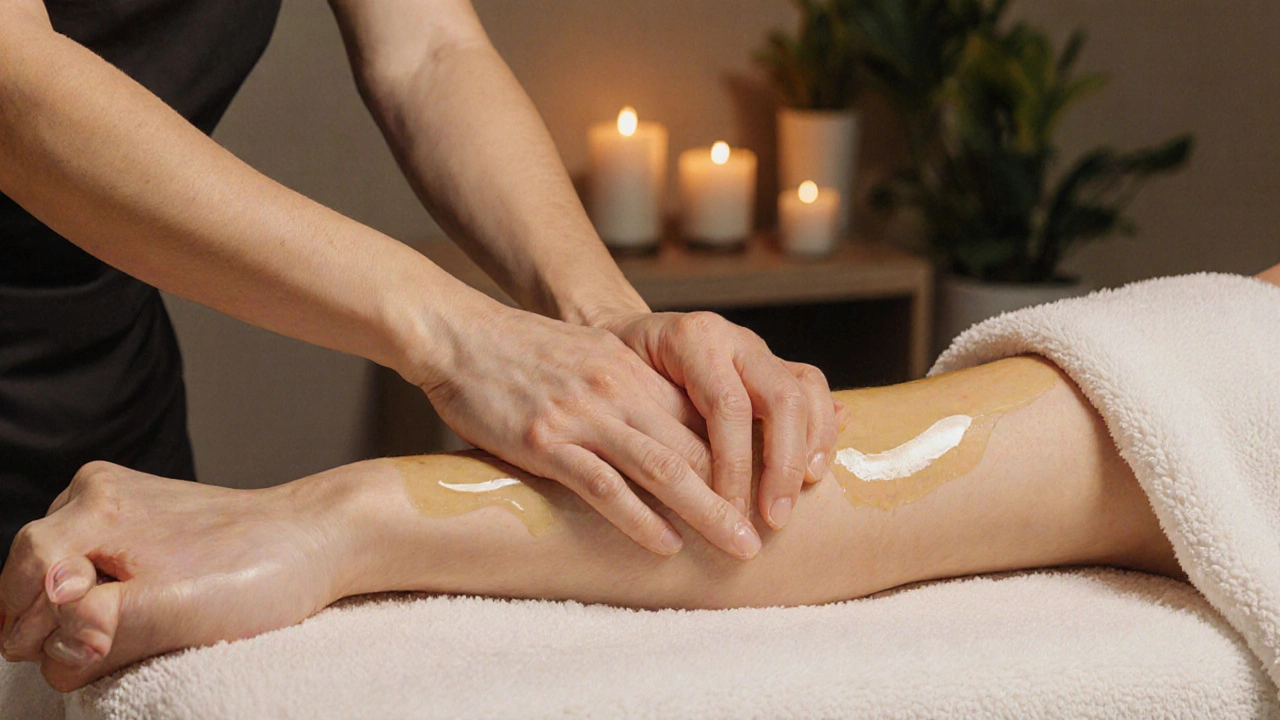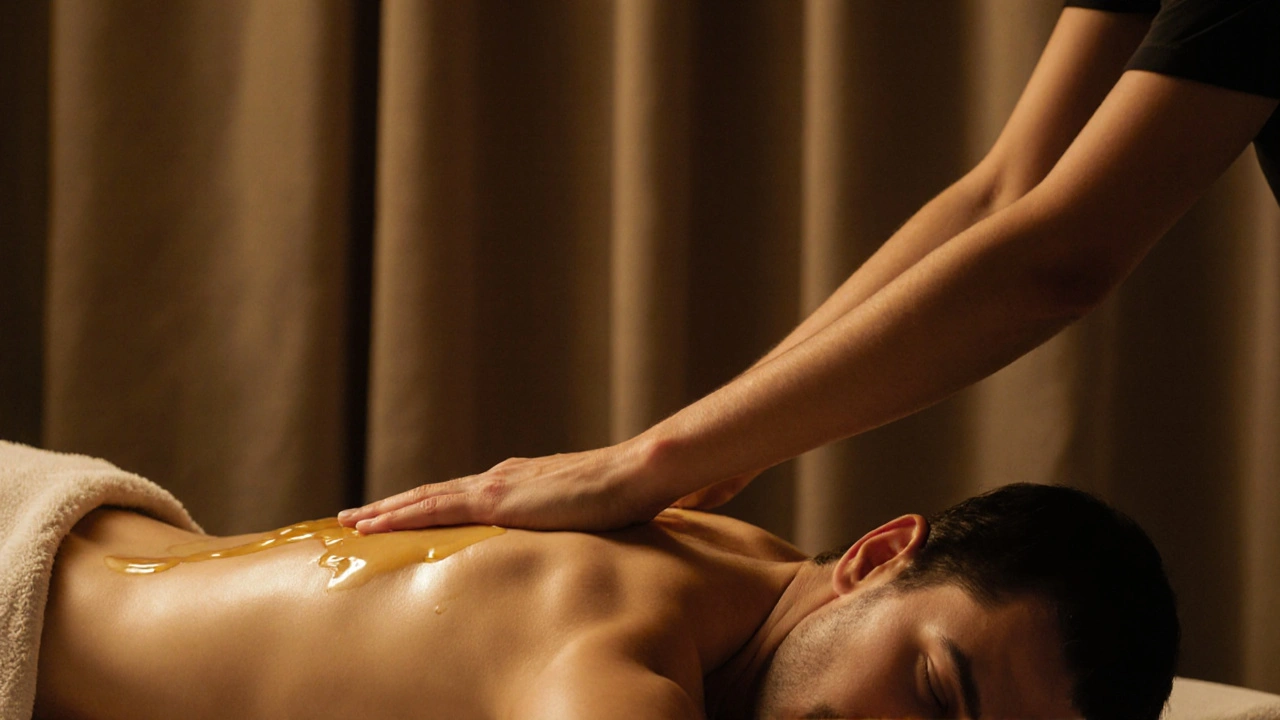You’ve heard about body to body massage. Maybe a friend mentioned it. Maybe you saw it online and felt curious-or confused. Is it romantic? Is it sexual? Is it even legal? You’re not alone. Thousands of people search for this every month, not because they want something scandalous, but because they’re looking for deep, immersive relaxation that traditional massage just doesn’t deliver. Let’s cut through the noise and tell you exactly what to expect-no hype, no hidden agendas, just real details.
What Is a Body to Body Massage?
A body to body massage is exactly what it sounds like: the therapist uses their own body-usually their arms, forearms, legs, or torso-to apply pressure, glide over your skin, and create flowing, rhythmic movements. Instead of just hands, they use the full surface of their skin, often with warm oil, to create a sensation that’s more like being wrapped in warmth than being rubbed.
This isn’t a new trend. It’s been practiced for centuries in parts of Asia and Southeast Asia, especially in traditional Thai and Nuru massage styles. But in modern wellness centers, it’s been refined into a therapeutic experience focused on deep muscle release, circulation, and nervous system calming. The key difference from a standard massage? There’s no barrier between you and the therapist’s skin. That direct contact creates a unique level of pressure control and sensory feedback that hands alone can’t replicate.
And yes-it’s sensual. But sensual doesn’t mean sexual. Think of it like the difference between holding hands and hugging someone you trust. One is intimate. The other is romantic. This massage leans into the first.
Why People Choose It (And What They Really Feel)
Most clients come in because they’re exhausted-not just tired from work, but emotionally drained. They’ve tried Swedish, deep tissue, even hot stone. Nothing stuck. Then they heard about body to body. They weren’t looking for romance. They were looking for a way to finally let go.
One client, a nurse who works 12-hour shifts, told me: “I didn’t realize how tight my shoulders were until I felt someone’s entire forearm glide down my spine. I cried. Not because it hurt. Because I hadn’t felt that safe in years.”
The magic isn’t in the technique alone. It’s in the combination of:
- Full-body contact that creates a sense of being held, not just touched
- Slow, continuous motion that tricks your nervous system into thinking you’re safe
- Warm oil that reduces friction and lets pressure flow like water
- Minimal talking-no small talk, no questions. Just presence.
Studies from the Journal of Bodywork and Movement Therapies show that prolonged, rhythmic skin-to-skin contact lowers cortisol levels by up to 31% in a single session. That’s more than a full night’s sleep in terms of stress reduction.
What Happens During a Session
Here’s the step-by-step of what you’ll actually experience-not what’s shown in movies.
- You arrive and check in. You’ll be asked to fill out a brief health form. Nothing invasive-just allergies, injuries, or recent surgeries.
- You’re guided to a private room. Soft lighting, warm temperature, calming music. No mirrors. No cameras. Just quiet.
- You undress to your comfort level. Most people keep underwear on. Some don’t. It’s your call. You’ll be covered with a towel at all times except the area being worked on.
- The therapist knocks, enters quietly, and explains the flow. They’ll ask if you prefer light or firm pressure. They’ll use warm oil-usually coconut, almond, or jojoba.
- They begin with your back. Using their forearms, they glide slowly from your neck down to your tailbone. It feels like a warm wave moving over you. No sudden movements. No poking. Just smooth, continuous pressure.
- They move to your legs, then arms, then shoulders. Each area gets 10-15 minutes. You’re never left alone, but you’re never watched either.
- The session ends with you lying on your back while they gently massage your chest and abdomen. This part is often the most surprising. It’s not erotic-it’s grounding. Like being held by someone who knows exactly how to help you breathe again.
- You’re given time to rest. A warm towel, herbal tea, and silence. Then you dress and leave feeling lighter than you have in months.
There’s no touching of genitals. No kissing. No flirting. The therapist’s role is to be a calm, professional presence-not a partner. Any boundary violation is grounds for immediate termination and legal action.

Who It’s For (And Who Should Skip It)
This isn’t for everyone-and that’s okay.
Best for:
- People with chronic muscle tension from desk jobs or physical labor
- Those recovering from trauma who need non-sexual touch to rebuild safety
- Anyone who finds traditional massage too “clinical” or disconnected
- People seeking deep relaxation without drugs or alcohol
Not for:
- Anyone uncomfortable with skin-to-skin contact
- People seeking sexual stimulation
- Those with open wounds, infections, or recent surgeries
- Anyone who feels pressured to “perform” or respond emotionally
If you’re unsure, try a regular Swedish massage first. If you leave thinking, “I wish they’d used more of their body,” then body to body might be your next step.
Where to Find It (And How to Spot a Reputable Place)
Not every spa that says “body to body” is legit. Some use the term as a cover. Here’s how to tell the difference:
- Look for licensed massage therapists-check their credentials on state licensing boards. A real therapist will have a license number you can verify.
- Read reviews with details. Look for mentions of professionalism, cleanliness, and boundaries. Avoid places with vague phrases like “intimate experience” or “romantic getaway.”
- Ask about their training. Reputable centers train staff in therapeutic anatomy, ethics, and consent. They’ll be happy to tell you.
- Visit in person. A clean, calm space with private rooms and clear policies is a good sign. If the place feels shady or rushed, walk out.
Most legitimate providers are in wellness centers, high-end spas, or holistic health clinics-not hotels or private residences. If someone says, “I’ll come to your place,” that’s a red flag.
What It Costs
Prices vary by city, experience, and duration. Here’s what you’ll typically pay in the U.S. as of 2025:
| Duration | Price Range | What You Get |
|---|---|---|
| 60 minutes | $120-$180 | Full-body session, basic oil, quiet environment |
| 90 minutes | $180-$260 | Deeper work, premium oils, extended relaxation time |
| 120 minutes | $260-$350 | Comprehensive release, aromatherapy, post-session tea and quiet room |
Anything under $100 for a 60-minute session is a warning sign. You’re paying for skill, time, and professionalism-not a quick rubdown. Most places accept credit cards and require advance booking.

Body to Body vs. Traditional Massage
| Feature | Body to Body Massage | Traditional Massage (Swedish/Deep Tissue) |
|---|---|---|
| Technique | Therapist uses body (arms, legs, torso) | Therapist uses only hands and forearms |
| Sensation | Waves of warmth, full-body embrace | Targeted pressure, focused on knots |
| Pressure Control | Softer, more fluid, adaptable | More rigid, often firmer |
| Emotional Impact | Often triggers deep release or tears | Usually relaxing, rarely emotional |
| Best For | Stress, trauma recovery, deep relaxation | Muscle pain, injury rehab, general upkeep |
| Cost (60 min) | $120-$180 | $70-$120 |
Frequently Asked Questions
Is body to body massage legal?
Yes, when performed by licensed professionals in regulated settings. It’s legal in most U.S. states and many countries as long as no sexual activity occurs. Licensed massage therapists follow strict codes of ethics. If a provider doesn’t have a license or refuses to show it, walk away.
Do I have to be naked?
No. You wear whatever makes you comfortable-underwear, a towel, or nothing. The therapist will drape you with a sheet or towel at all times. Only the area being worked on is exposed, and never in a way that feels invasive. Your comfort is the priority.
Will I feel aroused?
It’s possible. Skin-to-skin contact can trigger physical responses-even when there’s no sexual intent. That’s normal. A good therapist will recognize it and keep the session focused on relaxation, not reaction. If you feel uncomfortable, speak up. You have the right to stop at any time.
How often should I get this?
Most people start with one session to test how they feel. If it helps, once a month is ideal for stress relief. Some with chronic tension go every two weeks. But this isn’t a maintenance treatment like a haircut. It’s a reset. Listen to your body.
Can I bring a friend or partner?
No. This is a private, one-on-one experience. The space is designed for deep personal release. Bringing someone else disrupts the safety and focus. If you want a couples’ experience, look into partner massage workshops instead.
Final Thought: It’s Not About Sex. It’s About Safety.
The real gift of body to body massage isn’t the oil or the movement. It’s the rare chance to be touched without judgment, without expectation, without performance. In a world where we’re constantly being scanned, sold to, and stimulated, this is one of the few places left where touch is purely for healing.
If you’re ready to feel held again-not by someone else’s hands, but by their presence-then take the step. Book a session. Show up. Breathe. Let yourself be still. You might just find that the serenity you’ve been searching for was never out there. It was waiting for you to let someone else hold you.




Sean Marcus
November 1, 2025 AT 12:07prajesh varma
November 2, 2025 AT 03:25Selene Becmar
November 2, 2025 AT 05:21And yes-I cried. Not because it hurt. Because for the first time in years, I felt seen without being judged. The therapist didn't ask me how my week was. They just held me. And that? That was the revolution.
Carli Lowry
November 3, 2025 AT 02:54Also-no one mentioned the importance of breathwork during the session. That’s where the real nervous system reset happens.
Enuma Eris
November 4, 2025 AT 09:12George Christopher Ray
November 4, 2025 AT 14:32Rich Beatty
November 5, 2025 AT 21:24Cody Deitz
November 6, 2025 AT 18:16